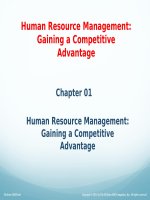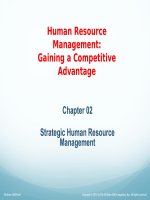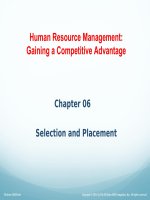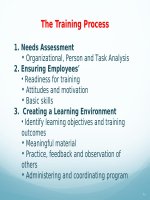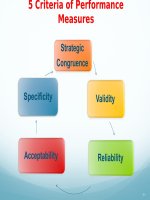Human resource management gaining a competitive advantage 9th edition by noe hollenbeck gerhart wright test bank
Bạn đang xem bản rút gọn của tài liệu. Xem và tải ngay bản đầy đủ của tài liệu tại đây (393.23 KB, 67 trang )
Human Resource Management: Gaining A Competitive Advantage 9th edition by
Raymond A. Noe, John R. Hollenbeck, Barry Gerhart, Patrick M. Wright Test Bank
Link full download test bank: />Link full download solution manual: />
Chapter 02 Strategic Human Resource Management Answer Key
True / False Questions
1.
The goal of strategic management in an organization is to deploy and allocate resources in a
way that it provides the company with a competitive advantage.
TRUE
The goal of strategic management in an organization is to deploy and allocate (physical,
organizational, and human) resources in a way that gives it a competitive advantage.
AACSB: Analytic
Accessibility: Keyboard Navigation
Blooms: Remember
Difficulty: 1 Easy
Learning Objective: 02-01 Describe the differences between strategy formulation and strategy implementation.
Topic: Introduction
2.
To be maximally effective, the human resource management function of a company must
be isolated from the company's strategic management process.
FALSE
To be maximally effective, the human resource management function of a company must be
integrally involved in the company's strategic management process. This means that human
resource managers should have input into the strategic plan, have specific knowledge of the
organization's strategic goals, know what types of skills, behaviors, and attitudes are needed
to support the strategic plan, and develop programs to ensure that employees have those
skills, behaviors, and attitudes.
AACSB: Analytic
Accessibility: Keyboard Navigation
Blooms: Understand
Difficulty: 2 Medium
Learning Objective: 02-01 Describe the differences between strategy formulation and strategy implementation.
2-29
Copyright © 2015 McGraw-Hill Education. All rights reserved. No reproduction or distribution without the prior written consent of McGraw-Hill
Education.
Topic: Introduction
3.
Strategic planning groups decide on a strategic direction during the strategy
implementation phase.
FALSE
During strategy formulation, the strategic planning groups of an organization decide on a
strategic direction by defining the company's mission and goals. During strategy implementation,
the organization follows through on the chosen strategy.
AACSB: Analytic
Accessibility: Keyboard Navigation
Blooms: Remember
Difficulty: 1 Easy
Learning Objective: 02-02 List the components of the strategic management process.
Topic: What is Strategic Management?
4.
Strategy implementation includes structuring an organization and allocating resources.
TRUE
During strategy implementation, an organization follows through on the strategy chosen in the
strategy formulation stage. This consists of structuring the organization, allocating resources,
ensuring that the firm has skilled employees in place, and developing reward systems that
align employee behavior with the organization's strategic goals.
AACSB: Analytic
Accessibility: Keyboard Navigation
Blooms: Remember
Difficulty: 1 Easy
Learning Objective: 02-02 List the components of the strategic management process.
Topic: What is Strategic Management?
2-30
Copyright © 2015 McGraw-Hill Education. All rights reserved. No reproduction or distribution without the prior written consent of McGraw-Hill
Education.
5.
In a two-way linkage, an organization is restricted from considering the human resource
issues while formulating their strategic plan.
FALSE
Two-way linkage allows for consideration of human resource issues during the strategy
formulation process. The strategic planning team informs the human resource management (HRM)
function of the various strategies the company is considering. Then HRM executives analyze the
human resource implications of the various strategies, presenting the results of this analysis to the
strategic planning team.
AACSB: Analytic
Accessibility: Keyboard Navigation
Blooms: Remember
Difficulty: 1 Easy
Learning Objective: 02-04 Describe the linkages between HRM and strategy formulation.
Topic: What is Strategic Management?
6.
Untapped labor pools are an example of a strategic threat to an organization's
operating environment.
FALSE
External analysis consists of examining an organization's operating environment to identify the
strategic opportunities and threats. Examples of threats include potential labor shortages, new
competitors entering the market, pending legislation that might adversely affect the company,
and competitors' technological innovations. Examples of opportunities are customer markets that
are not being served, technological advances that can aid the company, and labor pools that have
not been tapped.
AACSB: Analytic
Accessibility: Keyboard Navigation
Blooms: Understand
Difficulty: 2 Medium
Learning Objective: 02-04 Describe the linkages between HRM and strategy formulation.
Topic: Strategy Formulation
2-31
Copyright © 2015 McGraw-Hill Education. All rights reserved. No reproduction or distribution without the prior written consent of McGraw-Hill
Education.
7.
External analysis attempts to identify an organization's strategic opportunities and threats.
TRUE
External analysis consists of examining an organization's operating environment to identify
the strategic opportunities and threats.
AACSB: Analytic
Accessibility: Keyboard Navigation
Blooms: Remember
Difficulty: 1 Easy
Learning Objective: 02-04 Describe the linkages between HRM and strategy formulation.
Topic: Strategy Formulation
8.
Strategic choice describes the way an organization attempts to fulfill its mission and achieve
its long-term goals.
TRUE
The strategic choice is an organization's strategy; it describes the ways the organization will attempt
to fulfill its mission and achieve its long-term goals.
AACSB: Analytic
Accessibility: Keyboard Navigation
Blooms: Remember
Difficulty: 1 Easy
Learning Objective: 02-04 Describe the linkages between HRM and strategy formulation.
Topic: Strategy Formulation
9.
Job design addresses what tasks should be grouped into a particular job.
TRUE
Job design addresses what tasks should be grouped into a particular job. The way that jobs are
designed should have an important tie to the strategy of an organization because the strategy
requires either new and different tasks or different ways of performing the same tasks.
AACSB: Analytic
Accessibility: Keyboard Navigation
2-32
Copyright © 2015 McGraw-Hill Education. All rights reserved. No reproduction or distribution without the prior written consent of McGraw-Hill
Education.
Blooms: Remember
Difficulty: 1 Easy
Learning Objective: 02-05 Discuss the more popular typologies of generic strategies and the various HRM practices associated with
each.
Topic: Strategy Implementation
10.
The strategy a company is pursuing does not have an impact on the types of employees that
it seeks to recruit and select.
FALSE
Recruitment is the process through which an organization seeks applicants for potential
employment.
AACSB: Analytic
Accessibility: Keyboard Navigation
Blooms: Understand
Difficulty: 2 Medium
Learning Objective: 02-05 Discuss the more popular typologies of generic strategies and the various HRM practices associated
with each.
Topic: Strategy Implementation
11.
Training refers to a planned effort to facilitate the learning of job-related knowledge, skills,
and behavior by employees.
TRUE
A number of skills are instilled in employees through training and development. Training refers to a
planned effort to facilitate the learning of job-related knowledge, skills, and behavior by employees.
AACSB: Analytic
Accessibility: Keyboard Navigation
Blooms: Remember
Difficulty: 1 Easy
Learning Objective: 02-05 Discuss the more popular typologies of generic strategies and the various HRM practices associated with
each.
Topic: Strategy Implementation
2-33
Copyright © 2015 McGraw-Hill Education. All rights reserved. No reproduction or distribution without the prior written consent of McGraw-Hill
Education.
12.
Companies that are not diversified use objective measures of performance to evaluate managers.
FALSE
Companies that are "steady state" (not diversified) tend to have evaluation systems that call for
subjective performance assessments of managers. This stems from the fact that those above
the first-level managers in the hierarchy have extensive knowledge about how the work should
be performed.
AACSB: Analytic
Accessibility: Keyboard Navigation
Blooms: Remember
Difficulty: 2 Medium
Learning Objective: 02-05 Discuss the more popular typologies of generic strategies and the various HRM practices associated
with each.
Topic: Strategy Implementation
13.
Executives who have extensive knowledge of the behaviors that lead to effective performance
tend to focus on evaluating the objective performance results of their subordinate managers.
FALSE
Executives who have extensive knowledge of the behaviors that lead to effective performance use
performance management systems that focus on the behaviors of their subordinate managers.
AACSB: Analytic
Accessibility: Keyboard Navigation
Blooms: Remember
Difficulty: 1 Easy
Learning Objective: 02-05 Discuss the more popular typologies of generic strategies and the various HRM practices associated with
each.
Topic: Strategy Implementation
2-34
Copyright © 2015 McGraw-Hill Education. All rights reserved. No reproduction or distribution without the prior written consent of McGraw-Hill
Education.
14.
By tying pay to performance, a company can elicit specific activities and levels of performance
from employees.
TRUE
By tying pay to performance, a company can elicit specific activities and levels of performance
from employees.
AACSB: Analytic
Accessibility: Keyboard Navigation
Blooms: Remember
Difficulty: 1 Easy
Learning Objective: 02-05 Discuss the more popular typologies of generic strategies and the various HRM practices associated with
each.
Topic: Strategy Implementation
15.
Concentration strategies require that an organization bring radical change to the current skills
that exist in the organization.
FALSE
Internal growth strategies focus on new market and product development, innovation, and joint
ventures. Concentration strategies require that organization maintain the current skills that exist
in the organization.
AACSB: Analytic
Accessibility: Keyboard Navigation
Blooms: Understand
Difficulty: 2 Medium
Learning Objective: 02-05 Discuss the more popular typologies of generic strategies and the various HRM practices associated
with each.
Topic: Strategy Implementation
2-35
Copyright © 2015 McGraw-Hill Education. All rights reserved. No reproduction or distribution without the prior written consent of McGraw-Hill
Education.
16.
An overall cost leadership strategy is achieved primarily by offering unique product features.
FALSE
Overall cost leadership is achieved by constructing efficient large-scale facilities, by reducing
costs through capitalizing on the experience curve, and by controlling overhead costs and costs
in such areas as research and development, service, sales force, and advertising.
AACSB: Analytic
Accessibility: Keyboard Navigation
Blooms: Remember
Difficulty: 1 Easy
Learning Objective: 02-05 Discuss the more popular typologies of generic strategies and the various HRM practices associated with
each.
Topic: Strategy Implementation
17.
Companies engaged in a cost strategy require employees to have reduced concern for quantity
and a short-term focus.
FALSE
Companies engaged in a cost strategy require employees to have a high concern for quantity
and a short-term focus, to be comfortable with stability, and to be risk averse. These employees
are expected to exhibit role behaviors that are relatively repetitive and performed independently
or autonomously.
AACSB: Analytic
Accessibility: Keyboard Navigation
Blooms: Remember
Difficulty: 1 Easy
Learning Objective: 02-05 Discuss the more popular typologies of generic strategies and the various HRM practices associated with
each.
Topic: Strategy Implementation
2-36
Copyright © 2015 McGraw-Hill Education. All rights reserved. No reproduction or distribution without the prior written consent of McGraw-Hill
Education.
18.
Companies engaged in cost strategies develop internally consistent pay systems with negligible
pay differentials between superiors and subordinates.
FALSE
Companies engaged in cost strategies promote internally and develop internally consistent
pay systems with high pay differentials between superiors and subordinates.
AACSB: Analytic
Accessibility: Keyboard Navigation
Blooms: Understand
Difficulty: 2 Medium
Learning Objective: 02-05 Discuss the more popular typologies of generic strategies and the various HRM practices associated
with each.
Topic: Strategy Implementation
19.
Employees in companies with a differentiation strategy need to have only a moderate concern
for quantity.
TRUE
Employees in companies with a differentiation strategy need to be highly creative and cooperative;
to have only a moderate concern for quantity, a long-term focus, and a tolerance for ambiguity;
and to be risk takers.
AACSB: Analytic
Accessibility: Keyboard Navigation
Blooms: Remember
Difficulty: 1 Easy
Learning Objective: 02-05 Discuss the more popular typologies of generic strategies and the various HRM practices associated with
each.
Topic: Strategy Implementation
2-37
Copyright © 2015 McGraw-Hill Education. All rights reserved. No reproduction or distribution without the prior written consent of McGraw-Hill
Education.
20.
Differentiation companies will have compensation systems that are geared toward internal
rather than external equity.
FALSE
Differentiation companies will have compensation systems that are geared toward external
equity, as it is heavily driven by recruiting needs.
AACSB: Analytic
Accessibility: Keyboard Navigation
Blooms: Remember
Difficulty: 1 Easy
Learning Objective: 02-05 Discuss the more popular typologies of generic strategies and the various HRM practices associated with
each.
Topic: Strategy Implementation
21.
Strategies emphasizing market share or operating costs are called "external growth" strategies.
FALSE
Strategies emphasizing market share or operating costs are considered "concentration"
strategies. Strategies that attempt to integrate vertically or horizontally or to diversify are
exhibiting an "external growth" strategy, usually through mergers or acquisitions.
AACSB: Analytic
Accessibility: Keyboard Navigation
Blooms: Remember
Difficulty: 1 Easy
Learning Objective: 02-06 Describe the different HRM issues and practices associated with various directional strategies.
Topic: Strategy Implementation
2-38
Copyright © 2015 McGraw-Hill Education. All rights reserved. No reproduction or distribution without the prior written consent of McGraw-Hill
Education.
22.
Companies using concentration strategies attempt to focus on what they do best within
their established markets.
TRUE
Strategies emphasizing market share or operating costs are considered "concentration"
strategies. With this type of strategy, a company attempts to focus on what it does best within its
established markets and can be thought of as "sticking to its knitting."
AACSB: Analytic
Accessibility: Keyboard Navigation
Blooms: Remember
Difficulty: 1 Easy
Learning Objective: 02-06 Describe the different HRM issues and practices associated with various directional strategies.
Topic: Strategy Implementation
23.
Downsizing gives an organization the opportunity to change its culture.
TRUE
In spite of the various challenges, downsizing provides opportunities for human resource
management. Downsizing is often a unique opportunity to change an organization's culture.
AACSB: Analytic
Accessibility: Keyboard Navigation
Blooms: Remember
Difficulty: 1 Easy
Learning Objective: 02-06 Describe the different HRM issues and practices associated with various directional strategies.
Topic: Strategy Implementation
2-39
Copyright © 2015 McGraw-Hill Education. All rights reserved. No reproduction or distribution without the prior written consent of McGraw-Hill
Education.
24.
Companies going through downsizing often develop compensation programs that tie
an individual's compensation to the company's success.
TRUE
Companies going through downsizing often develop compensation programs that tie
an individual's compensation to the company's success.
AACSB: Analytic
Accessibility: Keyboard Navigation
Blooms: Remember
Difficulty: 1 Easy
Learning Objective: 02-06 Describe the different HRM issues and practices associated with various directional strategies.
Topic: Strategy Implementation
25.
A learning organization constantly monitors its environment, assimilates information, makes
decision, and flexibly restructures itself to compete in an ever-changing environment.
TRUE
A learning organization requires a company to be in a constant state of learning through
monitoring the environment, assimilating information, making decisions, and flexibly
restructuring to compete in an ever-changing environment. Companies that develop such
learning capability have a competitive advantage.
AACSB: Analytic
Accessibility: Keyboard Navigation
Blooms: Remember
Difficulty: 1 Easy
Learning Objective: 02-06 Describe the different HRM issues and practices associated with various directional strategies.
Topic: The Role of Human Resources in Providing Strategic Competitive Advantage
Multiple Choice Questions
2-40
Copyright © 2015 McGraw-Hill Education. All rights reserved. No reproduction or distribution without the prior written consent of McGraw-Hill
Education.
26.
Which of the following is a physical resource that a company uses to compete with
other companies?
A. Controlling system
B. Technology
C. Planning system
D. Employee skill
E. Experience of employees
A company can use a number of resources to compete with other companies. These resources
are physical (such as plant, equipment, technology, and geographic location), organizational (the
structure, planning, controlling, and coordinating systems, and group relations), and human (the
experience, skill, and intelligence of employees).
AACSB: Analytic
Accessibility: Keyboard Navigation
Blooms: Remember
Difficulty: 1 Easy
Learning Objective: 02-01 Describe the differences between strategy formulation and strategy implementation.
Topic: Introduction
27.
A(n) _____ typically charts how a firm will create value for customers and how it will do
so profitably.
A. design specification
B. business model
C. job characteristics model
D. administrative linkage
E. process architecture
A business model charts how a firm will create value for customers and, more important, how it
will do so profitably.
AACSB: Analytic
Accessibility: Keyboard Navigation
Blooms: Remember
2-41
Copyright © 2015 McGraw-Hill Education. All rights reserved. No reproduction or distribution without the prior written consent of McGraw-Hill
Education.
Difficulty: 1 Easy
Learning Objective: 02-01 Describe the differences between strategy formulation and strategy implementation.
Topic: What is a Business Model?
28.
_____ costs are incurred regardless of the number of units produced.
A. Acquisition
B. Procurement
C. Fixed
D. Variable
E. Marginal
Fixed costs are generally considered the costs that are incurred regardless of the number of
units produced. For instance, a firm producing widgets in a factory, has to pay the rent for the
factory, depreciation of the machines, the utilities, the property taxes, and so on.
AACSB: Analytic
Accessibility: Keyboard Navigation
Blooms: Remember
Difficulty: 1 Easy
Learning Objective: 02-01 Describe the differences between strategy formulation and strategy implementation.
Topic: What is a Business Model?
2-42
Copyright © 2015 McGraw-Hill Education. All rights reserved. No reproduction or distribution without the prior written consent of McGraw-Hill
Education.
29.
Which of the following statements is true of variable costs incurred by firms?
A. These costs are independent of the number of goods produced by firms.
B. The rent and interest paid by firms are examples of variable costs.
C. These costs are the difference between what firms charge for their products and the fixed
costs of the product.
D. These costs change directly with the units produced.
E. These costs refer to the total amount of margin made by a firm.
Variable costs are costs that vary directly with the units produced. For instance, all of the materials
that go into the production of a widget might cost a total of $10, which means that the firm has
to charge at least $10 per widget, to cover at least the variable costs of production.
AACSB: Analytic
Accessibility: Keyboard Navigation
Blooms: Remember
Difficulty: 1 Easy
Learning Objective: 02-01 Describe the differences between strategy formulation and strategy implementation.
Topic: What is a Business Model?
30.
Which of the following is an example of a fixed cost?
A. Raw materials
B. Factory rent
C. Operating cost
D. Direct labor costs
E. Packaging costs
Fixed costs are generally considered the costs that are incurred regardless of the number of units
produced. For instance, if you are producing widgets in a factory, you have the rent you pay for
the factory, depreciation of the machines, the utilities, the property taxes, and so on.
AACSB: Analytic
Accessibility: Keyboard Navigation
Blooms: Understand
Difficulty: 1 Easy
2-43
Copyright © 2015 McGraw-Hill Education. All rights reserved. No reproduction or distribution without the prior written consent of McGraw-Hill
Education.
Learning Objective: 02-01 Describe the differences between strategy formulation and strategy implementation.
Topic: What is a Business Model?
31.
The _____ margin is calculated as the number of units sold times the contribution margin.
A. holding cost
B. gross
C. profit
D. fixed cost
E. overhead rate
The gross margin is the total amount of margin a firm makes and is calculated as the number
of units sold times the contribution margin.
AACSB: Analytic
Accessibility: Keyboard Navigation
Blooms: Remember
Difficulty: 1 Easy
Learning Objective: 02-01 Describe the differences between strategy formulation and strategy implementation.
Topic: What is a Business Model?
32.
_____ refers to what is left after a firm pays its variable costs and fixed costs.
A. Contribution margin
B. Overhead cost
C. Profit
D. Variance
E. Holding cost
Profit refers to what is left after a firm pays its variable costs and fixed costs.
AACSB: Analytic
Accessibility: Keyboard Navigation
Blooms: Remember
Difficulty: 1 Easy
Learning Objective: 02-01 Describe the differences between strategy formulation and strategy implementation.
Topic: What is a Business Model?
2-44
Copyright © 2015 McGraw-Hill Education. All rights reserved. No reproduction or distribution without the prior written consent of McGraw-Hill
Education.
33.
A _____ workforce describes the former workers to whom a firm still owes financial obligations.
A. contingent
B. consultant
C. temporary
D. legacy
E. contract
A legacy workforce describes the former workers (i.e., those no longer working for the company)
to whom the firm still owes financial obligations.
AACSB: Analytic
Accessibility: Keyboard Navigation
Blooms: Remember
Difficulty: 2 Medium
Learning Objective: 02-01 Describe the differences between strategy formulation and strategy implementation.
Topic: What is a Business Model?
34.
Jonathan retired from a large multinational automobile company last year. He receives health care
benefits as well as a pension from the company. At present, Jonathan falls under the category of a
_____.
A. contingent workforce
B. legacy workforce
C. temporary workforce
D. consultant workforce
E. contract workforce
A legacy workforce describes the former workers (i.e., those no longer working for the company)
to whom the firm still owes financial obligations. In this scenario, Jonathan is a former employee
that the multinational automobile corporation still owes financial obligations.
AACSB: Reflective Thinking
Accessibility: Keyboard Navigation
Blooms: Apply
2-45
Copyright © 2015 McGraw-Hill Education. All rights reserved. No reproduction or distribution without the prior written consent of McGraw-Hill
Education.
Difficulty: 2 Medium
Learning Objective: 02-01 Describe the differences between strategy formulation and strategy implementation.
Topic: What is a Business Model?
35.
_____ is a process that primarily addresses the competitive challenges an organization faces.
A. Operational management
B. Transactional management
C. Management by objectives
D. Process mapping
E. Strategic management
Strategic management is a process, an approach to addressing the competitive challenges
an organization faces. It can be thought of as managing the "pattern or plan that integrates
an organization's major goals, policies, and action sequences into a cohesive whole."
AACSB: Analytic
Accessibility: Keyboard Navigation
Blooms: Remember
Difficulty: 1 Easy
Learning Objective: 02-01 Describe the differences between strategy formulation and strategy implementation.
Topic: What is Strategic Management?
2-46
Copyright © 2015 McGraw-Hill Education. All rights reserved. No reproduction or distribution without the prior written consent of McGraw-Hill
Education.
36.
When an organization develops integrated manufacturing systems such as advanced
manufacturing technology and just-in-time inventory control, it needs to assess the employee
skills required to run these systems and train them accordingly. These assessments and training
programs intended to enable an organization to achieve its goals fall under:
A. strategic human resource management.
B. the job characteristics model.
C. diversity management.
D. the employee stock ownership plan.
E. participative management.
Many firms have developed integrated manufacturing systems such as advanced manufacturing
technology, just-in-time inventory control, and total quality management in an effort to increase their
competitive position. However, people must run these systems. Strategic human resource management
in these cases entails assessing the employee skills required to run these systems and engaging in HRM
practices, such as selection and training, which develop these skills in employees.
AACSB: Analytic
Accessibility: Keyboard Navigation
Blooms: Understand
Difficulty: 2 Medium
Learning Objective: 02-01 Describe the differences between strategy formulation and strategy implementation.
Topic: What is Strategic Management?
2-47
Copyright © 2015 McGraw-Hill Education. All rights reserved. No reproduction or distribution without the prior written consent of McGraw-Hill
Education.
37.
During _____, the strategic planning groups decide on a strategic direction by defining the
company's mission and goals, its external opportunities and threats, and its internal strengths
and weaknesses.
A. strategy implementation
B. task design
C. selection and training
D. strategy formulation
E. strategy evaluation
During strategy formulation, the strategic planning groups decide on a strategic direction by
defining the company's mission and goals, its external opportunities and threats, and its
internal strengths and weaknesses. They then generate various strategic alternatives and
compare those alternatives' ability to achieve the company's mission and goals.
AACSB: Analytic
Accessibility: Keyboard Navigation
Blooms: Remember
Difficulty: 1 Easy
Learning Objective: 02-02 List the components of the strategic management process.
Topic: What is Strategic Management?
2-48
Copyright © 2015 McGraw-Hill Education. All rights reserved. No reproduction or distribution without the prior written consent of McGraw-Hill
Education.
38.
Pluto Inc., a large manufacturer of desktops and laptops, has decided to enhance revenues by
expanding its product line. It has identified the tablet market as a possible market to expand, and
has identified Compco Inc. as a potential competitor. Pluto Inc. is currently in the _____ stage of
the strategic management process.
A. strategy formulation
B. strategy evaluation
C. strategy execution
D. strategy consultation
E. strategy implementation
During strategy formulation, the strategic planning groups decide on a strategic direction by
defining the company's mission and goals, its external opportunities and threats, and its internal
strengths and weaknesses. They then generate various strategic alternatives and compare those
alternatives' ability to achieve the company's mission and goals. In the above scenario, revenue
enhancement is Pluto's goal and it has identified the tablet market as an opportunity. Pluto has
also identified Compco Inc. as a possible threat to it achieving its goal.
AACSB: Reflective Thinking
Accessibility: Keyboard Navigation
Blooms: Apply
Difficulty: 3 Hard
Learning Objective: 02-02 List the components of the strategic management process.
Topic: What is Strategic Management?
2-49
Copyright © 2015 McGraw-Hill Education. All rights reserved. No reproduction or distribution without the prior written consent of McGraw-Hill
Education.
39.
Saturn Inc. is a large manufacturer of footwear and accessories. It has always lagged behind its closest
competitor Hexagon Inc. It plans to overtake Hexagon by leveraging its strength in women's footwear
and entering markets in the Mid-West that it had traditionally ignored. Saturn Inc. is in the
_____ phase.
A. strategy implementation
B. strategy formulation
C. administrative linking
D. selecting and training
E. task designing
During strategy formulation, the strategic planning groups decide on a strategic direction by
defining the company's mission and goals, its external opportunities and threats, and its
internal strengths and weaknesses. They then generate various strategic alternatives and
compare those alternatives' ability to achieve the company's mission and goals.
AACSB: Reflective Thinking
Accessibility: Keyboard Navigation
Blooms: Apply
Difficulty: 3 Hard
Learning Objective: 02-02 List the components of the strategic management process.
Topic: What is Strategic Management?
2-50
Copyright © 2015 McGraw-Hill Education. All rights reserved. No reproduction or distribution without the prior written consent of McGraw-Hill
Education.
40.
During the strategic implementation stage of the strategic management process, an organization:
A. decides on a strategic direction.
B. defines its mission and goals.
C. establishes external opportunities and threats.
D. ensures that it has skilled employees in place.
E. determines its internal strengths and weaknesses.
During strategy implementation, an organization follows through on a strategy chosen in the
strategy formulation stage. This consists of structuring the organization, allocating resources,
ensuring that the firm has skilled employees in place, and developing reward systems that
align employee behavior with the organization's strategic goals.
AACSB: Analytic
Accessibility: Keyboard Navigation
Blooms: Remember
Difficulty: 1 Easy
Learning Objective: 02-02 List the components of the strategic management process.
Topic: What is Strategic Management?
2-51
Copyright © 2015 McGraw-Hill Education. All rights reserved. No reproduction or distribution without the prior written consent of McGraw-Hill
Education.
41.
Which of the following statements is true of a strategic implementation stage of the
strategic management process?
A. During this stage, an organization analyzes its strengths and weaknesses.
B. This is the first stage of the strategic management process, which is sequential in nature.
C. During this stage, an organization follows through on a strategy chosen in the
strategy formulation stage.
D. During this stage, an organization defines its mission and goals.
E. This stage is independent of the formulation stage in the strategic management process.
During strategy implementation, an organization follows through on a strategy chosen in the
strategy formulation stage. This consists of structuring the organization, allocating resources,
ensuring that the firm has skilled employees in place, and developing reward systems that
align employee behavior with the organization's strategic goals.
AACSB: Analytic
Accessibility: Keyboard Navigation
Blooms: Understand
Difficulty: 2 Medium
Learning Objective: 02-02 List the components of the strategic management process.
Topic: What is Strategic Management?
2-52
Copyright © 2015 McGraw-Hill Education. All rights reserved. No reproduction or distribution without the prior written consent of McGraw-Hill
Education.
42.
_____ component of the strategic management process consists of structuring the organization,
allocating resources, ensuring that the firm has skilled employees in place, and developing
reward systems that align employee behavior with the organization's strategic goals.
A. Task designing
B. Strategy implementation
C. Administrative linking
D. Strategy formulation
E. Operational implementation
During strategy implementation, an organization follows through on the strategy chosen in the
strategy formulation stage. This consists of structuring the organization, allocating resources,
ensuring that the firm has skilled employees in place, and developing reward systems that
align employee behavior with the organization's strategic goals.
AACSB: Analytic
Accessibility: Keyboard Navigation
Blooms: Remember
Difficulty: 1 Easy
Learning Objective: 02-02 List the components of the strategic management process.
Topic: What is Strategic Management?
2-53
Copyright © 2015 McGraw-Hill Education. All rights reserved. No reproduction or distribution without the prior written consent of McGraw-Hill
Education.
